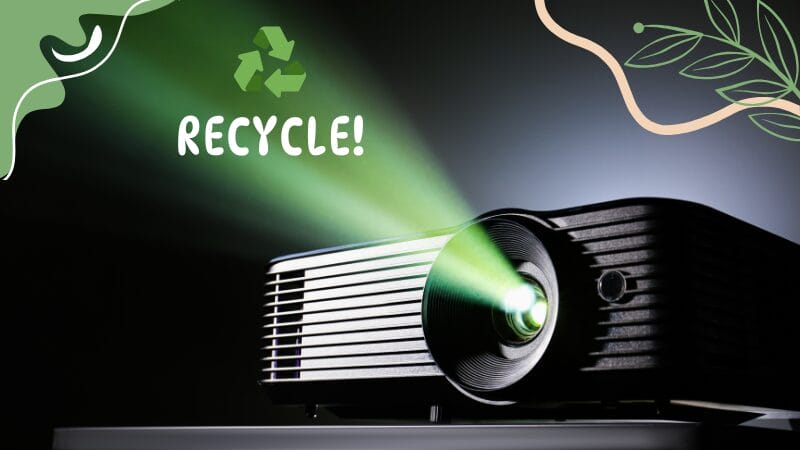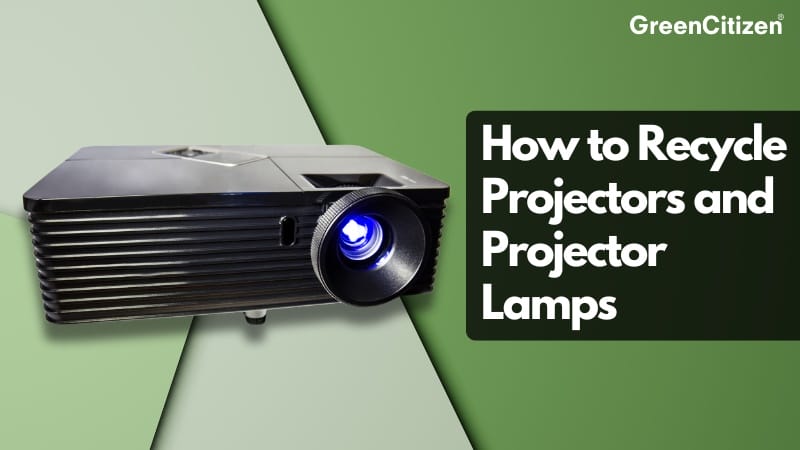When an office projector stops working or a lamp burns out, most IT teams swap it fast and stash the old gear in a supply closet. Months later, there’s a growing pile of broken projectors and burnt-out bulbs no one knows how to handle.
Projector recycling means safely disposing of projectors, bulbs, and lamps through certified e-waste programs that recover materials like mercury, glass, and plastics. Since most projector lamps contain hazardous elements such as mercury vapor and lead, tossing them in regular trash violates environmental regulations and can lead to fines.
Certified electronics recyclers and lamp recycling programs ensure these items are handled responsibly—many even offer free mail-in options for offices and IT departments managing bulk disposal.
This guide explains how to recycle projectors and projector lamps correctly — safely, legally, and with full environmental accountability.
Key Takeaway: How to Recycle Projectors and Projector Lamps
Both projectors and projector lamps can be recycled. Lamps must go through certified e-waste or lamp recycling programs because they contain mercury and lead, while projectors can be processed by R2 or e-Stewards recyclers that recover metals, glass, and plastics. Proper recycling prevents hazardous waste and keeps your organization compliant and sustainable.
Are Projectors and Projector Lamps Hazardous Waste?
Yes. Both projectors and projector lamps are considered hazardous electronic waste under environmental regulations such as the EPA’s RCRA and the EU WEEE Directive.
Projector lamps contain mercury vapor, lead solder, and metal halides — substances that can contaminate soil and groundwater if broken or discarded with household trash.
The projector housing itself qualifies as e-waste, containing printed circuit boards, optical lenses, and mixed plastics that require specialized recycling.
Recycling these devices not only prevents pollution but also recovers valuable materials such as aluminum, copper, and glass.
In most U.S. states, it’s illegal to throw projectors or lamps in regular trash. Offices should store used units safely and partner with certified e-waste recyclers or manufacturer take-back programs to ensure legal, responsible disposal.
How to Recycle Projector Lamps (and Bulbs) the Right Way
Projector lamps should always be recycled through certified e-waste or lamp recycling programs regulated by the EPA’s RCRA and the EU WEEE Directive.
These lamps contain mercury vapor, lead solder, and rare-earth metals such as yttrium and cerium. Proper recycling prevents toxic exposure, recovers reusable materials, and keeps your business compliant.
1. Identify Your Projector Lamp Type
Check the projector model or lamp housing. Most use UHP (ultra-high-pressure) or metal-halide lamps, while newer ones rely on LED or laser engines. Mercury-based lamps require hazardous waste handling, whereas solid-state units can enter standard e-waste streams.
2. Store Used Projector Lamps Safely
Never break or compress bulbs. Place each lamp in its original packaging or a sealed, padded container to prevent mercury release. For bulk collections, label boxes with lamp types and dates—this aids ESG tracking and simplifies compliance audits.
3. Use Certified Recycling Programs
Brands such as Epson and Dell operate take-back programs for lamps and projectors. Businesses can also partner with R2- or e-Stewards-certified recyclers like GreenCitizen, which document every unit via serialized tracking systems (e.g., GTAMS) and issue proof-of-recycling certificates.
4. Choose Free Or Mail-In Options When Available
Many recyclers and municipal household hazardous waste programs offer free drop-offs or prepaid mail-in kits. Corporate clients can request scheduled pickups with full downstream traceability to verify responsible processing.
5. Never Discard Lamps In Regular Trash
Throwing lamps in trash violates EPA and state e-waste laws. A single broken mercury bulb can contaminate tons of landfill material. Always recycle through authorized facilities to protect employees, meet ESG goals, and ensure responsible material recovery.

Can You Recycle Old Projectors? Projector Recycling Steps
Once a projector stops working or becomes obsolete, it’s classified as electronic waste (e-waste) under the EPA’s RCRA and the WEEE Directive. Unlike projector lamps, full units include optical lenses, cooling systems, and circuit assemblies that need specialized dismantling.
Recycling projectors the right way not only prevents environmental harm but also supports data protection, component recovery, and ESG documentation.
1. Disconnect Sensitive Components
Remove the lamp, remote batteries, and any detachable accessories. Store them separately — lamps follow hazardous waste rules, while remotes and cables can go into standard electronics recycling streams.
2. Protect Stored Data and Connectivity Modules
Many smart projectors include built-in memory, Wi-Fi modules, or Bluetooth pairing data. Always perform a factory reset or data wipe before disposal to prevent leaks of corporate information.
3. Choose Recyclers Offering ITAD and ESG Reporting
Instead of generic e-waste handlers, work with recyclers that provide IT asset disposition (ITAD) and chain-of-custody documentation. These services ensure verified recycling, carbon tracking, and safe removal of brominated plastics and metal composites.
4. Verify Compliance and Final Disposal
Request a proof-of-recycling certificate that confirms how and where materials were processed. Avoid donation of broken units — it transfers liability. Instead, confirm that the recycler meets state-specific e-waste mandates and uses traceable downstream partners.
♻️ Quick Tip: When bulk-recycling projectors from an office upgrade, combine the process with IT asset audits — you’ll save logistics costs and get consolidated compliance paperwork.
Overhead and Slide Projector Recycling (Legacy Equipment)
Overhead and slide projectors are classified as electronic waste (e-waste) when they reach the end of their service life. Although they don’t use mercury vapor lamps like digital projectors, they still contain circuit boards, fans, glass optics, and plastic housings that require certified recycling.
Overhead projectors typically rely on halogen bulbs, which can be recycled through standard e-waste channels. However, the transparency sheets used with them are usually made of polyester (PET) film — not recyclable in most municipal programs. Dispose of them through general waste unless a local facility accepts specialty plastics.
Slide and film projectors often include aluminum frames, glass lenses, and small electric motors. These components can be dismantled for metal and glass recovery. Functional or collectible models may hold reuse value for educators or vintage electronics buyers.
Non-working or bulk-retired units should be handled by R2- or e-Stewards-certified recyclers to ensure proper downstream processing and documentation for compliance. Educational institutions and offices can combine legacy AV items into a single e-waste pickup to simplify logistics and maintain environmental accountability.
♻️ Pro tip: Some recyclers partner with art schools or makerspaces that repurpose lenses, filters, or frames from analog projectors — a creative reuse path that keeps materials out of landfills.
FAQ: Projector and Projector Lamp Recycling
Yes. Many lamp recycling programs and e-waste centers accept projector lamps at no cost, especially for small quantities. Some local hazardous waste collection sites and municipal recycling events also process lamps for free. For bulk business disposal, certified recyclers may charge a small handling fee but usually include compliance documentation.
Most recyclers do not pay for used projector lamps because they contain hazardous materials such as mercury. However, working projectors or units with reusable parts may have resale value through electronics refurbishers or asset recovery programs. Always confirm whether a recycler offers “for-cash” recycling before scheduling pickup.
Search for certified e-waste recyclers or lamp collection sites in your area. Many hardware stores, universities, and local waste agencies host regular collection drives. When possible, choose recyclers certified under R2 or e-Stewards to ensure safe material recovery and legal compliance.
Yes. Projector lamps containing mercury or lead are classified as hazardous waste under U.S. and state e-waste laws. Throwing them in regular trash can lead to fines and environmental contamination. Always use approved recycling or manufacturer take-back programs for safe disposal.
Yes. Several recyclers and manufacturers offer mail-in recycling kits that let offices ship spent lamps directly to processing facilities. These programs are ideal for distributed teams or remote offices that can’t attend local collection events.
Final Thoughts: Responsible Projector Recycling Starts in the IT Room
Responsible projector recycling means treating end-of-life electronics as regulated assets, not clutter. Every IT room collects retired gear — routers, cables, and projectors that pile up after upgrades — but once they leave your office, they fall under EPA and e-waste compliance laws.
Projector lamps contain mercury and lead, while projectors hold circuit boards, lenses, and plastics that can be recovered through R2- or e-Stewards-certified recyclers. Recycling isn’t just about meeting regulations; it reflects an ESG-minded culture that values safety, sustainability, and transparency.
Before you order your next upgrade, audit existing devices, schedule a certified pickup, and close the loop responsibly. A few deliberate steps today keep your workspace cleaner, your audits simpler, and your environmental footprint smaller.
